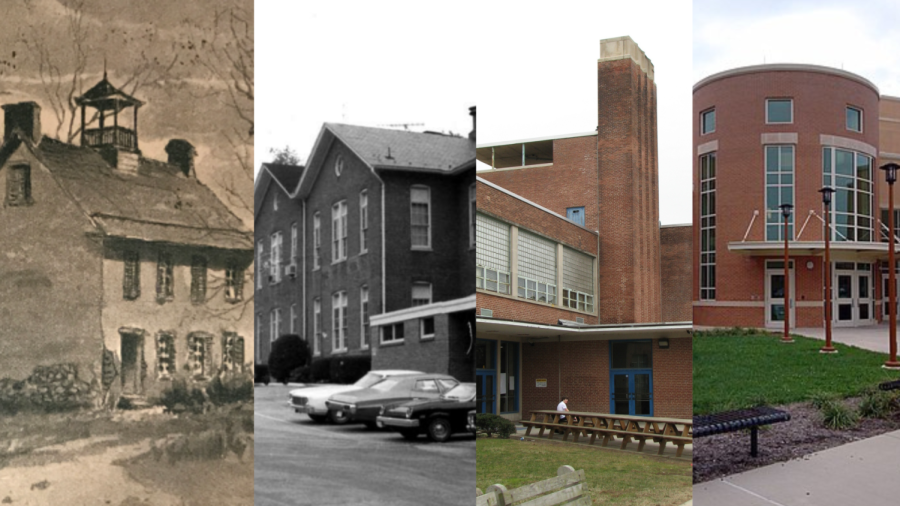A Brief History of BAHS
Bel Air High School: from 1815 to Today
The Bel Air High Schools, past and present
February 8, 2023
Divulging into the extensive past of one of the oldest academies in the United States should not be taken lightly; it should, however, be lengthy in addition to being held to a certain level of historical accuracy.
Please note that this overview will not only be briefer than it should, but assumptions and observations will be made that might not be entirely accurate. The most correct and readily available source at Bel Air High School is the collection of Bel Air High School’s El Adios yearbook publication, dating back to when the first edition was published in 1927.
In addition to these articles, numerous other documents and photographs were used from NPS, Our Harford History by C. Milton Wright, the Historical Society of Harford County, and various other websites (see list at end of article).
The Bel Air Academy
The Bel Air High School, formerly referred to as “The Bel Air Academy” (and, for a brief period prior to its construction, as the “Harford County Academy”), has been housed across five buildings. The academy was established on January 7th, 1812 and authorized on January 20, 1790, by an act of the state legislature. However, the school wasn’t “up and running” until 1815 (sometimes referred to as 1816) when Rev. Reuben Davis was promoted to the position of principal. “…because of his ability as an instructor and the high standards set by the school in its wide curriculum, the institution became widely known. Students from all of the country studied there…”1
The academy was so well known that it was rumored that at one point in time, there was a student from every state attending (there were only nineteen states when the school was established). The school, while being founded by an act of state legislature, was privately owned, and operated (like many schools of the time) by the board of academy trustees.
The board of academy trustees consisted of Thomas Hope, David Street, Joshua Rutledge, John Moores, William Smith, Henry Dorsey, Dr. Hugh Whiteford, John Street, John Forwood, William Wilson, Matthew Hawkins, James Wetherell, Elijah Davis, John Tolley and Paca Smith. The state did not begin to financially assist the academy until 1814; possibly due to the financial expenditures and hardships resulting from the war of 1812.
The first building was put into use throughout much of the 19th century and was built on Hickory Avenue in 1814. As was conveyed in his tax returns; a local merchant, Thomas A. Hays, the same man who later conveyed the title for the building and the immediate surrounding property for a total of $1.00 in 1839 (equivalent to around $32 in 2022). It is widely understood that the house was built to be a donation (there were other donors in addition to Hays) to the newfound academy, because of this it is not understood why exactly the title was not transferred to the school much earlier.
Thomas A. Hays (oftentimes designated as ‘the Father of Harford County’), while being more known as a generous donor to the school, he was also a ruthless slave owner, so terrible in fact that he and his forced labor camp is mentioned in an entry for the National Underground Railroad Network to Freedom. He owned approximately four thousand acres of land in Harford County and was known as one of the richest if not the richest in Harford County citizens at the time.
This entry stems from an excerpt from a book that interviewed enslaved person Samuel Archer, who was “owned” by Hayes for thirty years. In The Underground Railroad by William Still, “He grew very tired of Bell Air, Harford County, Maryland, and his so-called owner, Thomas Hayes. He said that Hayes had used him “rough,” and he was “tired of rough treatment.” So, when he got his plans arranged, one morning when he was expected to go forth to an unrequited day’s labor, he could not be found.”2 Worth noting is that the above spelling of Bel Air might have been just a typo, but the town’s name was changed from “Belle Aire” to “Bel Air” toward the end of the 19th century (the above text was published in 1872).
The curriculum for the academy was described as highly classical and because of this, it had many notable names attend the school including but not limited to, Gov. Augustus Bradford (32nd governor of Maryland), Actor and confederate sympathizer John Wilkes Booth, Judge Henry D. Harlan, Judge James D. Watters, Attorney General Thomas H. Robinson, along with many more influential names including doctors, politicians, judges, and several famous actors.
As the name may be more notorious than the others, John Wilkes Booth attended the academy and left the academy in 1853, just sixteen years before the assassination of Abraham Lincoln. While he is a notable alumnus well known around the school now, immediately following the assassination he was left out of many school descriptions; when the notable alumni of the school are listed somewhere in a text dating pre-1930 he is noticeably left out much of the time (especially when the text is from a local source or author). In fact, he is often replaced in history texts by the accomplishments his brother, who turned out to become quite the famous international Shakespearean actor, even after the Booth name became stained with blood in the eyes of the American public.
John was described by a classmate, George Maynadier in his memoir, as “…by no means deficient in intelligence and brains (very much in fact the other way), but was not “bookish,” which is all I mean, when I say he was not as a boy devoted to his studies…” 3
In the spring of 1849, the debate club hosted what many modern-day students would refer to as a ‘rager’; the club had some leftover funds accumulated and since the days were shortening, they decided to spend it all in one, grand final meeting. They even convinced a local bartender to provide some refreshments (alcohol) and the schoolboys baked various Sunday pastries. Maynadier describes, “The only thing that saved us from being expelled was that so many were engaged in the affair, equally guilty, that expulsion as a punishment would have broken up the school.”4
Many stories of the students and their mischievous actions are still told today, from snowball fights in the yard to the pupils climbing the bell tower and removing the clapper (the dangly bit in the middle of the bell) as well as engraving their names into the bell. One time, they even locked the principal out of the building!
The Graded School
By the 1880s the Bel Air Academy was facing low enrollment (due to the rise of public schools) and in 1888, the Bel Air academy moved to a large brick building on Gordon Street and the academy merged with the public school system. As of 1888, the school was at last renamed the ‘Bel Air Academy and Graded School’. Note that according to the 1927 El Adios yearbook, around this time and for a bit before, there is a “…period of time that elapsed in which reliable records were not kept.”5
The school was erected in 1882-83 then later renovated so the size nearly doubled in 1897 (there were several large-scale renovations done to expand the school). The Maryland Historical trust said in a report from 1979, “Particularly interesting is the large amount of window space in the building.”6 The school is, to this day, described by many Bel Air residents as a classic example of Victorian architecture in the local area, of which there are many.
Many modern-day Bel Air High School traditions can be drawn back to this building, one of which is the El Adios yearbook, with the first issue published in 1927. Another is The Bellarion (the school newspaper), which was founded*in 1942.
*There are no dates listed as to when the Bellarion was first published; however, the Historical Society of Harford County has multiple copies of both issues dated 1973 and 1974. Using the volume number on the issues I came to an estimate of 1942 as the year of creation; note that there is a possibility that this is incorrect.
You may have heard of this building by older generations calling it ‘the old board of education (BOE) building’ and while that is true, it was not the case until 1951, after the building had been around for nearly 70 years.
After the building laid dormant for several years (after the BOE moved to a new building on Hickory Avenue) the building was converted into apartments and two similarly sized buildings were built running parallel to it.
The schools title was swapped out for the last time in 1907 to the now current name, “Bel Air High School”. The reason for the name change is unclear.
The Graded School’s “Sister Building”
In 1924 a “sister school” was built to create more room for the school just off to the east. The old brick building was to hold the lower grades of 1st through 7th grades while the new school was meant to contain the high school grades (at the time this included grade 8).
The school was dormant after 1950, however, due to the construction of a newer, much more modern school building located on Heighe Street.
There isn’t much of a documented history of this building as it was around for a relatively short time (∼70 years). According to the Maryland Historical Trust, both buildings were set to be destroyed in 1979, only one of which (the eastern one) ended up being knocked down to make room for the new elementary school in 1983. There was a reported act of vandalism on the east building prior to its destruction resulting in the premature demise of its large, stain-glass window.
Segregated Schools
The original Bel Air Public school was built in 1867, across the street from what is now the Historical Society of Harford County on Main Street (old post office). In 1883, the school was moved to a location on Hays Street and converted to a school for African American Students (when the public school and academy merged in the brick building on Gordon Street).
Another building was built on Hays Street in 1924 and was occupied by the “colored school” in 1935. The school used the building until the mid-1950s (when the colored school merged with the local school system).
Segregated schools became unconstitutional in 1954 as ruled by the supreme court in Brown V. Board of Education. The Harford County BOE employed many tactics to delay the desegregation of schools, and a suit was subsequently filed against the board by twenty-one African American students in 1955. The road to fully integrated schools was a long one, involving the NAACP, several protests, and even more suits filled (Moore II v. BOE). This is all described more thoroughly in Nom. 105 of the Harford County Historical Bulletin, a publication by the Historical Society of Harford County.
By the latter half of 1966 schools in Harford County were all officially and successfully desegregated.
Heighe Street Building (1950-Today)
Due to the rapid suburban growth faced by Bel Air during and after the second world war, the need for a newer, larger school heightened. Over the next two decades, these ‘modern’ schools were built all over the county, one of which was built in the Town of Bel Air on Heighe Street. This building housed many of the more memorable decades of the high school’s history.
There is a notable transition in the layout/style of the yearbook as the school reached the second half of the 20th century. Button-up shirts with serious ties and plaid school skirts fell out of fashion as converse and college-branded crewnecks spread throughout the school population. The school was also known for having ‘state-of-the-art facilities’ for the time.
Many current teachers attended this very building and there are notable alumni such as Andrew Berry, the current general manager of the Cleveland Browns (NFL). The building was destroyed upon completion of the new neighboring high school, also on Heighe Street.
The ‘new neighboring high school’ mentioned before was completed in 2009 and is currently still in use. It is pictured above in our featured photo.
References
1,5 Class of 1927. El Adios. 1st ed., vol. 1, The Times Printing Company, 1927.
2 Still, William. The Underground Railroad A Record Of Facts, Authentic Narratives, Letters, &C., Narrating The Hardships, Hair-Breadth Escapes And Death Struggles Of The Slaves In Their Efforts For Freedom, As Related By Themselves And Others, Or Witnessed By The Author. PORTER & COATES, 1872.
3,4 “John Wilkes Booth at the Bel Air Academy.” LincolnConspirators.com, 14 July 2018, https://lincolnconspirators.com/2018/07/13/john-wilkes-booth-at-the-bel-air-academy/.
6 “NPGallery NRHP Archive Search.” National Parks Service, U.S. Department of the Interior, https://npgallery.nps.gov/NRHP/.


